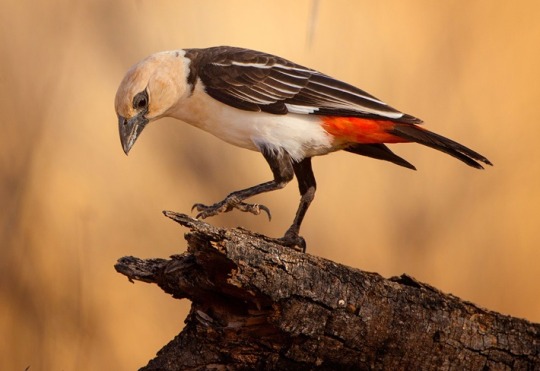#White-Headed Buffalo Weaver
Explore tagged Tumblr posts
Text

I got you stick
3 notes
·
View notes
Text










White-Headed Buffalo Weaver & Von der Decken's Hornbill ♂ | Binder Park Zoo | 2019
0 notes
Text
Me photographing a black and white animal in harsh sunlight

#photographer moment#looking at photos i took at the zoo of white headed buffalo weavers and yikes#so many blown out highlights#yeah ik they arent actually black and white theyre black and dark brown but same principle
0 notes
Text

white-headed buffalo weaver
#birds#illustration#acorviart#it's a little crunchy but that's the price I must pay to glaze non painterly art styles#anyway saw one of these at the zoo#little guy was screaming
2K notes
·
View notes
Text

White-headed or White-faced Buffalo-weaver (Dinemellia dinemelli), male, family Ploeceidae, Serengeti National Park, Tanzania.
photograph by Stuart Hahn
262 notes
·
View notes
Text


Cataloguing some birds to add to The Skull Index next week! Left to right: Black Browed Albatross, Black Necked Aracari, Green Aracari, Crimson Rumped Toucanet (x2), White Backed Vulture, African Spotted Eagle Owl, Common Raven, Moluccan Eclectus, Atlantic Puffin, Red Throated Barbet, White Headed Buffalo Weaver, Village Weaver, and Long tailed Broadbill.
#bird skulls#no mbta uk#vulture culture#skulls#my collection#bones#vulture culture uk#taxidermy#animal skull#animal skulls#vultureculture#skeletons#museum#natural history museum#the skull index#bird skull#birds#aves#avian#toucan#toucanet#aracari#vulture#albatross#raven#crow#puffin#owl
28 notes
·
View notes
Text

Vijay Pal Singh
White Headed Buffalo Weaver
Kenya, July 2023
100 notes
·
View notes
Text
Discover Uganda: Wildlife Safaris & Gorilla Trekking Tours | Camp Saja Safaris

Uganda is situated in the eastern part of Africa. It boasts a varied landscape that is truly captivating. This remarkable country provides numerous thrilling opportunities for exploration and observation. Its natural beauty is showcased through its diverse range of features. To name a few are its stunning nature reserves, captivating primates, majestic rivers, picturesque lakes, breathtaking beaches, and an abundance of wildlife.
Being a landlocked country, Uganda shares its borders with Kenya to the east, Congo to the west, Sudan to the north, and Tanzania and Rwanda to the south. The equatorial region in Uganda was gifted with lush rainforests, vast deserts, and magnificent waterfalls. Leading safari operators in Uganda collaborate with visitors, making their tours and safaris an effortless and ideal experience.

Uganda offers incredible opportunities for game viewing and wildlife safaris. The diverse landscape supports a wide range of animals, including primates and gorillas. Tourists can expect to encounter over 75 different species of animals, including the famous Big Five (elephants, buffaloes, leopards, lions, and rhinos). Other species such as hippos and giraffes can also be found in Uganda's sanctuaries.
The country is home to several national parks, including Kedipo Valley National Park, Queen Elizabeth National Park, Bwindi Impenetrable National Park, Volcanoes National Park, and Murchison National Park. Murchison National Park, located in the northwest and situated on the shore of Lake Albert, is the oldest and largest park in Uganda.
Uganda safari holiday packages include Birding safaris. It offers the opportunity to spot a variety of bird species. Some notable birds include the Blue-headed Coucal, Giant and Malachite Kingfishers, Squacco Heron, Swamp Flycatcher, Sandpipers, Abyssinian Ground-Hornbill, Black-billed Barbet, Weaver Birds, Pied Kingfisher, Piapiac, Silver bird, Eastern Grey Plantain-eater, African Quail-Finch, Red-throated Bee-eater, Speckle-fronted Weaver bird, White-browed Sparrow Weaver bird, Black-headed Gonolek, Denham’s Bustard, and many more.
The Boating part of your Uganda safari holiday package takes you to the best places for sport fishing. It is a popular safari activity in Uganda. The Nile River provides excellent opportunities for fishing, especially when the water level is low and clear. Tour operators in Uganda can arrange boating safaris and fishing trips, allowing visitors to catch fish and witness the majestic giant crocodiles that inhabit the river.
The open grasslands of Uganda are a thriving ecosystem where predators and grazers coexist during the dry season. This unique encounter between different species is a sight to behold.
Uganda is renowned for its gorilla population, with approximately half of the world's gorillas residing in the country. The Gorilla safari part of your Uganda tours and safaris truly make you stunning. The chimpanzee trekking in Kibale Forest is a key attraction for primate enthusiasts.
Exploring the conservation areas surrounding the national parks on foot is a great way to immerse oneself in the natural beauty of Uganda. Ensure that you seize these indelible yet unforgettable moments with your camera.

Several fascinating things are there to watch in Uganda. Leading Safari operators in Uganda are always conscious about providing the best service all the time. They are very knowledgeable about Wildlife, Birds, Trees, Uganda Society, Customs, and traditions about the country. They can lead you by offering the sights and experiencing things that some can dream of. The Tour Operators can make you feel relaxed, and amazed by the sights, sounds, smells, and greenery of nature.
Leading safari operators in Uganda like Camp Saja Safaris always try to provide tourists with new appreciation and understanding about the wildlife. This is where you can book a holiday tour with a great combination and your choice among various adventures. They help in finding suitable and convenient itineraries for the perfect destination as per the needs of the tourists and budget. They are very much conscious about the comfort of the visitors and foreign tourists. The most capable, friendly, and helpful guides at Camp Saja Safaris share their talent, experience, and understanding with clients. It will bring an awesome experience among the tourists which they take back home. They make sure that Uganda safari holiday packages are designed as per tourist’s satisfaction.
East Africa is a memorable destination that should not be missed. Camp Saja Safaris made a great contribution to their clients’ satisfaction. They are one of the leading safari operators in Uganda and offer various customized tour packages as per clients' needs! For any assistance in conquering your thoughts, and passion for nature and wildlife photography please get in touch with Camp Saja Safaris at +1 (443) 409 2106.
Content Source From: www.thelifestyle-blog.com
#Uganda Safari#Gorilla Trekking#Wildlife Safari#African Adventure#Uganda National Parks#Bird Watching Uganda#Uganda Travel#Eco-Tourism Africa#Uganda Cultural Tours#Nature Tours Uganda#Uganda Holiday Packages#Adventure Travel#African Wildlife#Uganda Conservation#Hiking in Uganda#Uganda Wildlife Photography#Uganda Tours#Sustainable Travel Uganda#Uganda Safari Experience#Primate Safaris
3 notes
·
View notes
Text

White-headed buffalo weaver
1 note
·
View note
Photo

A new variant has been added!
White-headed Buffalo Weaver (Dinemellia dinemelli) © Henrik Grønvold
It hatches from beautiful, chunky, conspicuous, distinctive, large, open, other, penetrating, red, squeaky, white, and whole eggs.
squawkoverflow - the ultimate bird collecting game 🥚 hatch ❤️ collect 🤝 connect
1 note
·
View note
Text
Animal of the Day!
African Pygmy Falcon (Polihierax semitorquatus)

(Photo by Fanis Theofanopoulos)
Conservation Status- Least Concern
Habitat- Northeastern and southwestern Africa
Size (Weight/Length)- 62 g; 20 cm
Diet- Insects; Lizards; Small birds
Cool Facts- The African pygmy falcon may look adorable but they are certainly fierce. Only a little larger than a sparrow, these falcons are the smallest bird of prey in all of Africa. Living in symbiosis with white-headed buffalo weavers, the African pygmy falcon benefits from the weaver’s massive communal nest while the falcon chases off possible threats to the weavers such as snakes. While African pygmy falcons typically live in monogamous pairs, sometimes several pairs will call a single, large weaver nest home.
Rating- 12/10 (Tiny, deadly, helpful neighbor.)
#Animal of the day#Animals#Birds#Bird of prey#Falcon#Saturday#August 13#African Pygmy Falcon#biology#science#conservation#the more you know
50 notes
·
View notes
Text
Orts, Meghan Murphy, 2021
When coral and poppy lipsticks melt into waxy pools they are scraped away. Yet the empty tubes remain, rimmed with colorful remnants of time.
The residue of laughing painted lips cling to hollow silver shells. The stifled air, moist with trapped memories, turns acidic, tarnishing the silver bullets in blues and greens. The weaker metals succumb to corrosion and the smooth geometric objects of the vanity descend into the mirrored surface…an infinite reflected universe of pock-marked moons and rust-cratered pits. Glass perfume bottles, whose contents have long-since evaporated, reveal droplets of gooey condensation on the inside.
Every time I turn on a faucet the water splutters in mud brown streams before finally fading to a pale yellow trickle.
Inside this house there is no letting go.
We can’t even replace the carpets, until the carpets speak for themselves—abruptly unraveling to trip us up. Failing plumbing stains the walls in murky teardrops, rivulets cascading down, down into the earth—and the same shade of paint is used to cover up the blooming mold. The wallpaper-ed rooms are less lucky—if the wallpaper is no longer in production then it stays, doomed to gradually be absorbed by the sweating house. A bathroom with walls of vibrantly colored, life-sized birds has faded from ornate detail to abstract shapes. The yellow finch that used to watch me with a discerning eye, has been reduced to the silhouette for a toddler’s puzzle.
The house gasps, groans, wheezes and secretes …
There are birds of all materials here. Porcelain eagles, taxidermy ducks and pheasants, delicate glass swans, a bronze peacock figurine…..
On the wall of the den is the mounted head of an indeterminant creature. Its mouth is open to reveal pointed white teeth and I see my brother and I reflected in the protruding marble eyes.
“It’s a fox,” I say.
“No,” my brother responds resolutely. “It’s an opossum.”
The toy box, an excavation site where the heavy wooden blocks of my mother’s childhood lay at the bottom and my own plastic toys float towards the top, all webbed together by the roots of tangled doll hair. We prefer to play with the bronzes—a collection of dog-sized statues line a room, an infinite circular migration. We climb on to ungiving saddles, little hands grasping cold buffalo horns and clutching at the faces of stoic Mohican chiefs.
I am all too aware of the constant surveillance that follows my padded footsteps. The walls are covered in heavy oil paintings, depicting dramatic scenes of nature—a ship caught in the throes of an angry sea, horses (so many herds of horses) in various landscapes—galloping, grazing, leaping into the air with rolling white eyes—and two large portraits of them, stationed in the heart of the house.
The grand piano sits below their looming faces—a glossy sacrificial altar. The ebony surface is covered in a clutter of picture frames, the many factions of a tangled family tree. The newest faces and unions vie for the front, dangerously close to the edge, while past, ended marriages and children long grown linger in the back.…. It’s the photos that don’t make it in the frames that matter—those candid moments that break through the glossy sheen.
I enter rooms on tip-toe, and hold my breath, always waiting for…what? To see the statues scramble back into place? The portraits conversing? I can’t even find peace in the bathroom, where a framed, larger-than-life nude woman bathes in the moonlight, glancing accusatorially over her shoulder at me.
And when it all becomes unbearable, all that empty, heavy space, all the unblinking eyes, I defy the house the only way a child can. I open the home stereo system, installed under the old record player, and press play on the album ‘Now That’s What I Call Music. 9.’ There is something immensely satisfying about filling the space with the pulsating base of Missy Elliot and dancing spastically around the house. Pausing in front of china cabinets and display cases to flail my limbs wildly. I am both defying the on-looking artefacts and also moving, running, prancing, and crawling for them. I scream the obscene lyrics, and when I don’t know the words I fill the void with howls, yelps and guttural cries.
In the summer, we collect dozens of inky black tadpoles from the pond and bring them inside to observe their evolution into frogs. With transfixed satisfaction we watch the wiggling amphibians absorb their tails and gills, to sprout webbed feet, gradually preferring the floating branches to the depths of the tank.
By the time the frogs are leaping and croaking, their startling ruckus is too erratic and I can feel the house expelling their presence. When I release the frogs, I think of the mounted fox, collecting dust in his perpetual snarl, glass stags frozen in flight, the bronze boar in everlasting terror and the hounds always tensed to lunge.
We have granted these things a power and their stillness now vibrates with a tension that will surely crack if the white porcelain arms of ballerinas, extended high over heads, don’t finally rest.
Every closet and drawer is filled with them. Racks of dresses hang in a shocking burst of color that even years of mothballs can’t subdue. Stacked boxes of white leather gloves, waiting to either mold itself to my skin in a permanent grasp or disintegrate from the shock of warm, pulsating flesh. His imposing army of suits, the outgrown shells of a larger-than-life man.
Over the years, we grow bolder and shift through her dresses, fingering the stiff fabrics and choosing our favorites.
“Try them on girls,” they whisper.
We are all silent as the rigid materials swallow our pre-pubescent bodies, but there is no warm encasing or folding of fabric over our slight frames. The dresses stubbornly maintain their womanly shapes, and we are just sticks propping up the figure of her.
It’s when we start to move that the ritual commences. There is something intimate and precious, and thrilling, because we know it is wrong to be wearing her clothes. In these gowns we feel elegant and graceful and hold our heads high as we twirl and pirouette through the house like a coronation—a sense of importance and birth-right.
We baptize the stiff dresses in our sweat and the dusty-dry fabric greedily soaks in youthful beads of perspiration…a secretion of inheritance.
…10 years later
“Now that I’ve left, when I come back to the house I feel like that boy, Holden, from Catcher in the Rye,” he says with a half-smile. His posture is rigid though, and I find my brother’s resigned behavior maddening, as if we hadn’t spent our childhood living here. Hands stuffed in his coat, he winds through the room, giving the furnishings a wide berth.
“Remember,” he continues, “how Holden loved the Natural History Museum as a child and suddenly he can’t bear going back because he’s changed and everything remains the same inside the museum?”
I only vaguely remember something about a red (or was it orange?) hat and a carousal. His eyes finally land on the oversized portraits of our great-grandparents, dominating the living room, and his expression sets.
“Meg,” he is resolute but I can sense a dread in his voice that alarms me.
“I love you and I want to set you free.” He emphasizes “free” as if it means so much more than I understand.
“Sometimes the power of a place, an artefact, or a story, can help guide us into our own. But this has gotten way out of hand. We,” he gestures around the room to indicate our family, “we were once the weavers of our truth. But, suddenly our hands couldn’t keep up with the loom, or it was like the loom didn’t need us anymore…and now we’re tangled, trapped, suffocating in our own creation, while the story shuttles on. I hope that you are able to let it all go…leave this tangled mess where it lies. Perhaps pause to wonder at the knots, frayed ends, and faded dyes…at this jumbled creature that has enveloped you, and what it once was. I want you to feel the blood start to circulate back into limbs that you haven’t even realized are numb, wrapped up in this vice-like thread. When all this is over, maybe take a strand or two with you to carry around as a reminder.”
In the back of my mind I can hear my cousins’ comments about how lost my brother is. How ungrateful he is to turn his back on all that our family has worked so hard to achieve, and how our spoiled upbringing is the only explanation for his dissatisfaction.
“I don’t understand…”
He surges on:
“You know how Grandpa taught me how to fish? And how I was so excited that I nearly hooked myself in the eye?” I smile fondly as he touches his brow, where a small scar disrupts the arc of hair.
“That never happened. I got this scar from hitting my head on the coffee table. I don’t even like fishing. And I barely remember them!”
He gestures accusatorily at the serene, smiling faces on the wall.
I am horrified.
I was born shortly after my great-grandparents had died, and grew up envying and reveling in everyone else’s memories of them.
“I started to catch on that everybody in our family had these special moments with them, and that there was never any kind of timeline or specific setting. And everyone is always trying to up each other with how meaningful their memories are. Aunt Susan got herself into trouble when she went a bit too far with her sailing story, involving that storm and shipwreck, forgetting that Grandpa never learned to swim.”
He picks up a porcelain horse from the mantle-piece and snaps a leg off. For a moment I swear I hear the terribly crisp ‘crack!’ of breaking glass, resounding through the house. Instead, there is only my own sharp gasp and a dull splintering sound.
“This isn’t hand-made, limited edition porcelain from Vienna. It’s acrylic. Probably from China. Maybe there was an original figurine once-upon-a-time, and maybe Grandma really did smuggle it back from Europe in her jacket, but this particular one is the third acrylic replica—in our lifetime—to be placed here.”
He looks at me pleadingly, “surely you must have caught-on that something was up…”
I look around the room; was there an imperceptible dulling of color and light? Had there always been so much…stuff? Every surface is covered with the treasured belongings of my great-grandparents. I finger the scratchy wool of pillows she crocheted. Here was his rifle collection, above a desk littered with her stationary and a heavy glass paper weight. And suddenly I feel those binding ties that he had been talking about. Every object, painting, and photograph that has been eternalized in my memory over the years, is connected to me by hundreds of threads tied to my ribcage. As I stare at the tremoring silky strands, I wonder whether I spun this web or if the objects themselves cast the net. And now I can never unsee or un-feel myself caught, suspended, propped-up in this thing. I realize that these are ties only I can sever. But what if these little connections are what hold me upright? I picture myself a crumpled heap on the floor, with no more wonder and certainty to buoy me back up.
“Hurry!” My brother says, an edge of desperation in his voice, “before it is too late.”
I frantically begin to pull…and pull and pull and the fibrous strings just keep coming….slipping, wet and glistening, through my skin… and then with a panic I press on my stomach and, instead of my bottom ribs, all I feel is soft, vulnerable intestines. I am unraveling myself. I am this thread, and I was moments away from unmaking myself.
Suddenly, my brother’s face transforms. As I watch, it continues to mutate between gender and age, and yet there is something familiar looking back at me. In skin that is soft, taut, and lined—all at once—I glimpse iterations of the same eye-shape, and pointed chin. And I am not afraid. “You have passed the test. And so, you have earned these—The Scissors of Acceptance, and The Stone of Truth.” They pass me a pair of small silver scissors and a whetstone, that sits reassuringly in the palm of my hand.
“But ask yourself: why was it so easy for my little tale and demonstration to nearly unspool you?”
When does the silence of family secrets, glaring omissions and mysterious gaps, accumulate to become more substantial than what is known? Perhaps the unspoken and unacknowledged is the backbone of the narrative. Perhaps one doesn’t necessarily contradict, or negate, the other.
I can not pull, or exorcise this thing from my body; I must accept it for what it is and be grateful that it supported my trembling legs until I could stand on my own. I use The Scissors of Acceptance, sharpened by The Stone of Truth, to cut the strings. Each snip of the scissors is a snapped chord—a violent jerk, quivering, and finally stillness.
I leave the house. And these ‘orts’—leftover fragments of the past—trail behind me in a soft silver wake. As I continue moving, the ghostly little strings begin to tentatively seek each other, connect like grasping hands, and eventually these remaining ties are the beginning of something new, and whole. A sheening garment, light as air, covers me like a second skin—as comforting as a blanket and protective as armor.
See more of Meghan’s work at: https://www.everythingforever.net/meghan-murphy
1 note
·
View note
Text
Power Rangers Shinobi Strike

(Logo by @masterpikachu6)

Centuries ago in Japan a wicked and cruel man led an army in an attempt to rule everything. However a group of shinobi rose up to fight him. Desperate for victory the wicked man opened a portal to the demon realm but him and his army were pulled into it. A blacksmith created a special sealing shuriken and the shinobi split this key into five pieces. They took the pieces and spread around the world to prevent the key from being reformed. Time passed and each shinobi began a family and their skills and tools were passed on as well. These included a scroll detailing the events of the battle and a Shinobi Shuriken. However a demonic Kitsune managed to steal the key shards and reopen the portal. The wicked man had become a Demonic Emperor with an army of Nonja. However time has left him weakened and so they send the Nonja out to harness fear to bring him back to his former glory. He also sends out shurikens charged with demonic power to create modern day Yokai. The current heirs to the five shinobi gather in a city near the site where the portal is weakest and unleash their power as the Power Rangers Shinobi Strike! With Ninpo and the tools and powers of the shinobi they fight back against the Demonic Emperor as their ancestors once did. After rescuing a man and his family the five are allowed to live in his martial arts dojo. Each ranger has power over an element but only via a special shuriken. One of their earliest tasks is to teach each other how to utilize the other elements.

Red Shinobi Ranger- The Burning Ninja- Alexis Georgiou Kokinos Age: 20 Personality/Bio: Born in Greece, Alexis and his family made their home on Santorini Island, in the shadows of the volcano on the island. He is a very hot blooded and energetic young man. When it comes to innocent life he is very reckless, not afraid to jump into danger to rescue others. His Key Shard was the last one stolen and he sent out the alarm to the rest of the Shinobi as he followed the thief. He found them and tried to engage them but almost lost if not for the arrival of the other Shinobi Rangers. He holds the element of fire within him and can use his element’s power to burn his enemies or create a smokescreen. As the leader of the team, known as The Burning Ninja, he holds the Red Shinobi Ranger powers. Face Claim: Kostas Martakis

Blue Shinobi Ranger- The Storming Ninja- Simon Weaver Age: 19 Personality/Bio: Simon was born in the United Kingdom. He received his Blue Shuriken and Blue Shinobi Scroll from his uncle when he was young. As The Storming Ninja, Simon can control water, using it to drown his enemies or freeze it to create shields to shield himself and his friends. When the alarm about the theft of the Key Shards went out he was the second to arrive to save Alexis. He is the second-in-command of the team and the team strategist. He prefers to have his nose stuck in a book, rather than a battle, but when lives are on the line, he takes his Ranger duties seriously and fights alongside the rest of his team. Face Claim: Matthew Rhys Bond

Yellow Shinobi Ranger- The Quaking Ninja- Tito Cézar Almeida Costa Age: 21 Personality/Bio: Known as The Quaking Ninja, Tito was born in Brazil. For years he worked in his family’s quarry, so he’s no stranger to hard work. He is the physically strongest member of the team and the one they rely on to do the heavy lifting. He has a kind personality and does his best to fulfill his Ranger duties. He is often the peacekeeper of the group. After the theft of the Key Shards he received the Yellow Shuriken and Yellow Shinobi Scroll and became the Yellow Shinobi Ranger. He controls the element of earth and can use it to bury his enemies under layers of dirt or use dust to create a cloud to distract his enemies or make a quick getaway. Face Claim: Alex Meraz

White Shinobi Ranger- The Flowery Ninja- Monique Dupont Age: 18 Personality/Bio: One of the youngest of the team, Monique is a student at the local university in agricultural sciences in Paris, growing up there her entire life. Her father was an American and her mother a French botanist, fluent in English and French. She grew up with a natural affinity for flowers, and all plants in general and is skilled in botany. As The Flowery Ninja the element of wood grows within her and she can use it to slice her enemies like wheat or defend herself and others like the mighty oak. Monique was given the White Shinobi scroll along with a White Shuriken when she was old enough. After the theft of the Key Shards she was sent to find the others. Face Claim: Lily-Rose Depp

Pink Shinobi Ranger- The Metallic Ninja- Anna Zamolodchikova Age: 18 Personality/Bio: The same age as Monique, the two women got along from the start. A prodigy with machines as a result of growing up in a Russian junk yard. Anna has grown up with her hands in the gears as she tinkers away at the machines her family has built. As The Metallic Ninja the element of metal shines within her and can create sharp blades or solid barriers. When she was old enough she was given a Pink Shinobi scroll along with a Pink Shruiken. Following the theft of the Key Shards she left to find the other Shinobi Rangers Face Claim: Harley Quinn Smith

Gold Shinobi Ranger- The Starry Ninja- Danielle “Dan” Anders Age: 23 Personality/Bio: Boisterous and loud while morphed, Danielle is a pretty shy and meek person in real life. The descendants of the blacksmith who created the key shuriken moved to the western United States and created their own tools and weapons to aid in the battle should the need arise. Danielle is the latest in this line. At first she resented the fact that she was a ranger, not willing to accept the responsibilities she wanted more to focus on her music In the end however her heart is in the right place, and she’s trying to make things right. When the Shinobi Rangers began to battle the Nonja her family began work on the Gold Ranger gear so she could join the battle. As The Starry Ninja the element of the void roars within her allowing her to strike enemies with bolts or blow them away with strong winds. In her down time she composes songs based on the noise and sounds of the battles. Face Claim: Jasmin Savoy Brown The different families each created their own Shinobi Zords over the years, however they each had a different idea for a theme. R- Shinobi Warrior Zord- A red humanoid who can use ninja skills in battle B- Shinobi Drago Zord- A blue dragon who can breathe flames Y- Shinobi Truck Zord- A yellow truck that can spread ninja traps W- Shinobi Hound Zord- A white dog that can spread chaos in battle P- Shinobi Train Zord- A pink train that speeds around in combat
These five unite to form the Shinobi Megazord
R- Sits in the torso and forms the head B/Y- Arms W/P- Legs
G- Shinobi Western Zord with Buffalo Buggy- A cyan humanoid that rides upon a buffalo styled buggy. These two can combine to form the Rodeo Megazord.
Both Megazords can become one and form the Shinobi Rodeo Megazord
By using their Ninpo to purify the demonic shurikens the team gains a set of auxiliary Shinobi Zords Shinobi Elephant Zord- An emerald elephant that can use its trunk to attack and combine with the Shinobi Megazord to form the Shinobi Elephant Megazord granting the megazord twin axes. The Elephant Shuriken also allows the Rangers to stretch their limbs to amazing lengths Shinobi Alien Zord- A navy UFO that attacks by manipulating gravity and can combine to form the Shinobi Alien Megazord. This megazord is armed with a powerful blaster. The Alien Shuriken can also be used by the Rangers to manipulate gravity as well Shinobi Submarine Zord- A purple submarine that can control waves and shoot missiles and can combine to form the Shinobi Surfer Megazord. This megazord rides a giant surfboard and can move at great speed. The Submarine Shuriken can be used by the Rangers to summon localized waves. In the aftermath of a difficult battle the Rangers are forced to flee and they stumble onto a fortress with a lion motif and take shelter within. While inside they discover the fortress is really the Shinobi Lion Fortress Zord and activate it. This zord can become the Shinobi Lion Megazord as well as combine with the other Megazords to form the Shinobi Superzord.
Within the Lion Fortress the Rangers find the True Ninpo Armor. This armor boosts a Ranger’s power tenfold. The True Ninpo Armor acts as a team Battilizer.
However as the Nonja army grew stronger the Rangers were forced to return to their homelands to find statues of ancient Shinobi Guardians. These statues bestowed new Zords onto the Rangers. The Shinobi Guardian Zords.
R- Shinobi Guardian Phoenix Zord- Statue found within a volcano B- Shinobi Guardian Drake Zord- Statue found within a cave on a cliff side Y- Shinobi Guardian Turtle Zord- Statue found within a cave on a beach W- Shinobi Guardian Tiger Zord- Statue found within the forest P- Shinobi Guardian Panda Zord- Statue found in a blizzard in the wastelands G- Shinobi Guardian Fish Zord- Statue found in a canyon
Shinobi Guardian Megazord: R- Head B/G- Arms Y- Chest W/P- Legs
The Shinobi Guardian Megazord can unite with the Shinobi Lion Megazord to form the Shinobi Ultrazord.
Ninpo- In the Power Rangers universe there are three types of ninja. Ninjor is a master of all three. 1. Ninjetti which uses the power of the users inner ninja beast (MMPR3/Aquitar) 2. Ninjitsu which uses the element the user is in harmony with (Ninja Storm) 3. Ninpo which uses the users own life force to perform incredible feats. However most people cannot use Ninpo too much without becoming weaker from the strain, the Shinobi Rangers use special Shurikens to balance this.
Power Rangers Rail Strike: One day one of the demonic shurikens hits the wreckage of a Shadowtrack train and turns it into a monster bent on reviving the fallen Darkness Emperor. It takes two teams of rangers to stop him. Ninja vs Ninja For years it was believed Ninjor was the only one of his kind. This is not true. There was once another, a red being known as Shinor. Where Ninjor was compassionate Shinor was cruel. Where Ninjor defended life Shinor destroyed it. Where Ninjor’s students were heroes Shinor’s students were the silent killers of legend. Eventually Ninjor had no choice but to seal Shinor within Shinor’s own temple and hide it from humanity. It was in this prison Shinor remained, until a man fleeing justice broke into the temple. This wicked man was tempted by Shinor’s promises of power and released him. Within moments Shinor betrayed the man and began his plan for revenge. He gathered enemies of the Ninja Rangers (Aquitar, Ninja Storm, and Shinobi Strike) leading to the three teams joining forces along with Ninjor to defeat the threat.
Morphers- Shinobi Morphers (hand held ranger colored shurikens) Morphing Call- Shinobi Technique! Ninpo Transformation! Morphing- The shuriken passes through the ranger creating the suits out of ranger colored energy. (Bios by @dream-chef-flavors and @rosegrl18)
Power Rangers Rail Warriors<———-Powerverse——–> Power Rangers Beast Might
5 notes
·
View notes
Photo

White Headed Buffalo Weaver
1 note
·
View note
Quote
I. The Red Flag The newspapers said the strikers would hoist the red flag of anarchy over the silk mills of Paterson. At the strike meeting, a dyers’ helper from Naples rose as if from the steam of his labor, lifted up his hand and said here is the red flag: brightly stained with dye for the silk of bow ties and scarves, the skin and fingernails boiled away for six dollars a week in the dye house. He sat down without another word, sank back into the fumes, name and face rubbed off by oblivion’s thumb like a Roman coin from the earth of his birthplace dug up after a thousand years, as the strikers shouted the only praise he would ever hear. II. The River Floods the Avenue He was the other Valentino, not the romantic sheik and bullfighter of silent movie palaces who died too young, but the Valentino standing on his stoop to watch detectives hired by the company bully strikebreakers onto a trolley and a chorus of strikers bellowing the banned word scab. He was not a striker or a scab, but the bullet fired to scatter the crowd pulled the cork in the wine barrel of Valentino’s back. His body, pale as the wings of a moth, lay beside his big-bellied wife. Two white-veiled horses pulled the carriage to the cemetery. Twenty thousand strikers walked behind the hearse, flooding the avenue like the river that lit up the mills, surging around the tombstones. Blood for blood, cried Tresca: at this signal, thousands of hands dropped red carnations and ribbons into the grave, till the coffin evaporated in a red sea. III. The Insects in the Soup Reed was a Harvard man. He wrote for the New York magazines. Big Bill, the organizer, fixed his good eye on Reed and told him of the strike. He stood on a tenement porch across from the mill to escape the rain and listen to the weavers. The bluecoats told him to move on. The Harvard man asked for a name to go with the number on the badge, and the cops tried to unscrew his arms from their sockets. When the judge asked his business, Reed said: Poet. The judge said: Twenty days in the county jail. Reed was a Harvard man. He taught the strikers Harvard songs, the tunes to sing with rebel words at the gates of the mill. The strikers taught him how to spot the insects in the soup, speaking in tongues the gospel of One Big Union and the eight-hour day, cramming the jail till the weary jailers had to unlock the doors. Reed would write: There’s war in Paterson. After it was over, he rode with Pancho Villa. IV. The Little Agitator The cops on horseback charged into the picket line. The weavers raised their hands across their faces, hands that knew the loom as their fathers’ hands knew the loom, and the billy clubs broke their fingers. Hannah was seventeen, the captain of the picket line, the Joan of Arc of the Silk Strike. The prosecutor called her a little agitator. Shame, said the judge; if she picketed again, he would ship her to the State Home for Girls in Trenton. Hannah left the courthouse to picket the mill. She chased a strikebreaker down the street, yelling in Yidish the word for shame. Back in court, she hissed at the judge’s sentence of another striker. Hannah got twenty days in jail for hissing. She sang all the way to jail. After the strike came the blacklist, the counter at her husband’s candy store, the words for shame. V. Vivas to Those Who Have Failed Strikers without shoes lose strikes. Twenty years after the weavers and dyers’ helpers returned hollow-eyed to the loom and the steam, Mazziotti led the other silk mill workers marching down the avenue in Paterson, singing the old union songs for five cents more an hour. Once again the nightsticks cracked cheekbones like teacups. Mazziotti pressed both hands to his head, squeezing red ribbons from his scalp. There would be no buffalo nickel for an hour’s work at the mill, for the silk of bow ties and scarves. Skull remembered wood. The brain thrown against the wall of the skull remembered too: the Sons of Italy, the Workmen’s Circle, Local 152, Industrial Workers of the World, one-eyed Big Bill and Flynn the Rebel Girl speaking in tongues to thousands the prophecy of an eight-hour day. Mazziotti’s son would become a doctor, his daughter a poet. Vivas to those who have failed: for they become the river. Martin Espada, “Vivas To Those Who Have Failed: The Paterson Silk Strike, 1913″ from Vivas To Those Who Have Failed. Copyright © 2015 by Martin Espada. Reprinted by permission of W. W. Norton & Company, Inc.. Source: Vivas To Those Who Have Failed(W. W. Norton and Company, Inc., 2015) Martín Espada BiographyMore poems by this author Poem of the Day: Vivas To Those Who Have Failed: The Paterson Silk Strike, 1913 Poem of the Day: Vivas To Those Who Have Failed: The Paterson Silk Strike, 1913 Poem of The Day {$excerpt:n} Source: Poem of The Day
http://babakziai.org/poem-of-the-day-vivas-to-those-who-have-failed-the-paterson-silk-strike-1913/
1 note
·
View note
